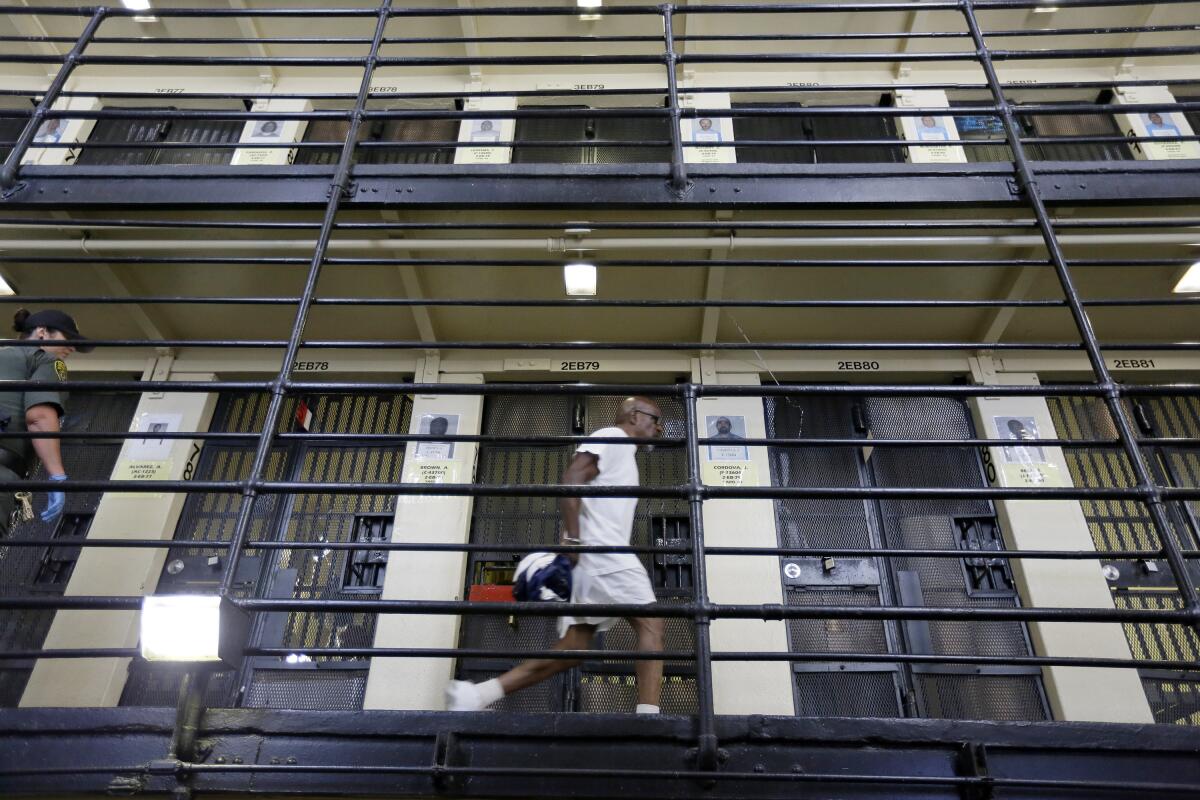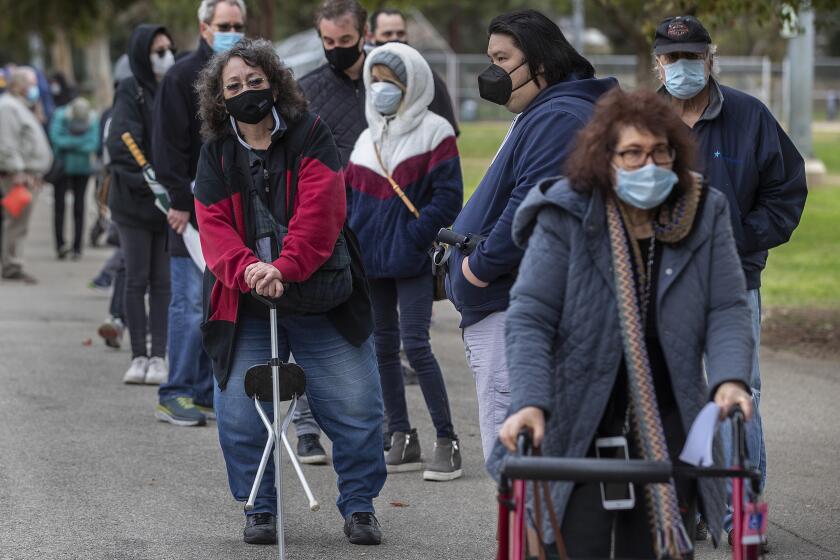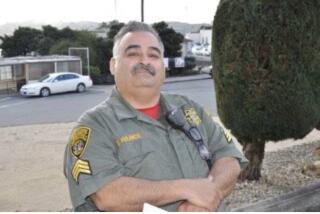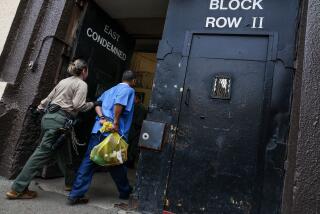Prison officials ignored warnings before inmate transfer that led to virus outbreak, watchdog says

- Share via
California corrections officials ignored the warnings of front-line health workers and pressured them to hastily transfer 189 potentially coronavirus-infected inmates from a Chino men’s prison last May, triggering a deadly outbreak of COVID-19 at San Quentin State Prison, the state watchdog reported Monday.
By the end of August, 2,237 inmates and 277 staff members had been infected at San Quentin, according to the California Office of Inspector General’s report. Twenty-eight prisoners and one staffer ultimately died there.
The report heaped blame on the California Department of Corrections and Rehabilitation and California Correctional Health Care Services, or CCHCS, for creating a “public health disaster” at San Quentin, the state’s oldest prison. A smaller state prison in Corcoran, which received 67 of the 189 transfers, was affected to a lesser extent.
“Our review found that the efforts by CCHCS and the department to prepare for and execute the transfers were deeply flawed and risked the health and lives of thousands of incarcerated persons and staff,” the report noted.
“Insistence by CCHCS and the department to execute the transfers and subsequent pressure to meet a tight deadline resulted in the California Institution for Men ignoring concerns from health care staff and transferring the medically vulnerable incarcerated persons, even though the vast majority had not been recently tested for COVID-19,” it said.
By relying on outdated test results, “the prison had no way to know whether any of the incarcerated persons were currently infected with the virus,” the report said.
The transfers from Chino came after corrections officials and lawyers representing inmates agreed the men had to be moved from the prison’s barracks-style housing, where the the virus was spreading quickly.
At the time of the moves, the Chino prison reported more than 600 cases of COVID-19 and nine deaths. The 189 were among 700 inmates selected for transfer who had medical conditions that made them especially vulnerable to the virus.
Internal emails cited by the inspector general showed that medical staff at the Chino prison raised alarms before the transfers were made.
The night before the first transfers, a supervising nurse emailed to alert a medical executive that some of the inmates had not been tested for nearly a month — far too early to be an effective gauge of infection.
“Is there a re-swabbing criteria to be met before transfer,” the nurse asked, suggesting that retesting was called for.
“No re-swabing,” the executive replied 11 minutes later.
In another email, a Chino prison manager sounded the alarm to a department headquarters manager about potentially spreading the virus.
“I’m surprised HQ wants to move our inmates right now,” the email read. “But we have to make sure that we are not infecting another institution.”
San Diego County has California’s largest cluster of known cases of B.1.1.7.
That and other internal warnings were brushed aside, and the Chino inmates were bused to San Quentin in late May. Corrections officials violated their own health guidelines for inmate capacity on some of the trips, according to the inspector general.
Two of the inmates had COVID-19 symptoms upon arrival, including one with a fever of 101.1 degrees. But even though the San Quentin health staff suspected that the Chino inmates had been exposed to the coronavirus, the prison housed 119 of them in a unit that lacked solid doors, which allowed air to flow freely through the cells.
By the time COVID-19 test results came back, 14 infected inmates had been housed in the unit for at least six days, the report noted.
“The virus spread quickly, both to the other incarcerated persons who transferred from the California Institution for Men, as well as to the 202 incarcerated persons already housed in the same unit,” the report said.
By Aug. 6, more than half of the inmates on the unit had tested positive. Of the 122 newly arrived Chino prisoners, 91 eventually tested positive, and two died from complications related to COVID-19.
In a joint statement Monday, corrections and prison healthcare officials said the transfers were made “with the intent to mitigate potential harm” to the Chino inmates and were based on “a thoughtful risk analysis using scientific information available in May 2020 concerning transmission of this novel disease.”
“We have acknowledged some mistakes were made in the process of these transfers,” the statement said, “and both CCHCS and CDCR have made appropriate changes to patient movement since that time.”
The changes included increased testing, quarantining and enhanced use of personal protective equipment, according to the statement.
“Currently, San Quentin has only four patient cases, and has remained in single digits in terms of COVID-19 positive patient cases since August,” the statement said.
In addition to San Quentin’s 28 COVID-related deaths, 27 inmates have died at the Chino prison and three at Corcoran. In all, 192 inmates have died statewide among more than 47,400 who tested positive.
The deaths have sparked outrage from prisoner advocates and legal action by some inmates’ families.
In September, lawyers for the family of 61-year-old Daniel Ruiz filed a government claim, a precursor to a lawsuit against the corrections agency. Ruiz died July 11 after contracting the virus while serving time in San Quentin for a minor drug crime.
“It is tragic and unacceptable that some prison bureaucrats treated them as less than human,” attorney Michael Haddad said.
After reviewing the inspector general’s report, he added: “If these prison officials’ goal was to give prisoners COVID-19, it is hard to think what they could have done more effectively.”
Angela Cadena, vice president for the inmate advocacy organization We Are Their Voices, said that for those with loved ones in California prisons, the report was not surprising.
“Maybe to some this is news, but to us this has been happening since day one,” said Cadena, whose husband is incarcerated at the Richard J. Donovan Correctional Facility near San Diego. He tested positive for the coronavirus, she said, but continued to work as a porter serving food to other inmates.
“It’s traumatic not only to me as a wife but to my children,” Cadena said. “They live with the fear of getting that phone call, and the harsh reality is we did get that phone call.”
Corrections officials on Monday also defended their transparency in handling the health crisis they helped create.
In October, however, they denied a public records request by The Times that had been pending since July, seeking emails and other communications related to the botched transfer.
“Collecting and reviewing these records would divert critical staff resources from the public health response underway in response to the emergency and is not in the public interest, particularly when the vast majority of responsive records, if not all records, will be exempt from disclosure,” officials wrote in denying the request.
The inspector general’s report also noted difficulty in getting records from the department.
Healthcare in the state prison system has been the subject of long-running litigation that predates the pandemic.
In July, J. Clark Kelso, the federal-court-appointed receiver overseeing prison medical care, announced the removal of Dr. R. Steven Tharratt as the system’s statewide medical director, citing the challenges of the COVID-19 pandemic.
“In order to meet current response needs while also working toward further delegation of medical care back to state control, it has become evident that a reorganization is necessary for long-term sustainability,” Kelso said at the time.
Tharratt, who was appointed to that post by the receiver in 2010, shifted to become a special healthcare advisor to the receiver.
Kelso himself has come under fire from state lawmakers. In October, six of them asked U.S. District Judge Jon Tigar to immediately remove Kelso and replace him “with an individual committed to the health and safety of incarcerated persons.”
Assemblyman Marc Levine (D-San Rafael) said, “Mr. Kelso’s mismanagement of the COVID-19 pandemic at CDCR correctional facilities resulted in the worst public health disaster in CDCR history.”
Kelso did not respond to requests for comment Monday.
Hadar Aviram, a professor at UC Hastings College of the Law who litigated the release of inmates from San Quentin because of COVID-19, said corrections officials have no excuse for their handling of the transfers.
“You have evidence in black and white that they knew of the danger,” Aviram said. “This is not the same as a mistake. They made a decision to risk people’s lives. This is the textbook example of deliberate indifference.”
Army Specialist Vincent Polanco, whose father, Gilbert Polanco, died of COVID-19 in August after likely contracting it while working as a San Quentin corrections sergeant, also holds officials accountable.
“Every day I live in dreams about my dad, what life could have been like,” said the younger Polanco, who sees the corrections department “as my family” and wants to be a guard himself when he finishes his active duty.
He said the “higher-ups” in the system failed his father.
“Now all the sudden they are doing everything they should have been doing since the beginning, now that they are scared,” he said. “It really hurts me to see that leadership really messed up and didn’t take the initiative to save my dad’s life.”
More to Read
Sign up for Essential California
The most important California stories and recommendations in your inbox every morning.
You may occasionally receive promotional content from the Los Angeles Times.













